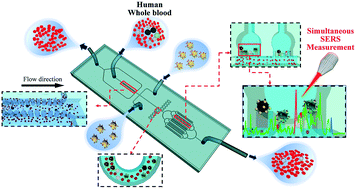Simultaneous single-cell phenotype analysis of hepatocellular carcinoma CTCs using a SERS-aptamer based microfluidic chip†
Abstract
Hepatocellular carcinoma (HCC) is a harmful malady that truly debilitates human health, and hence it is of significance to isolate and on-line profile the phenotype of HCC cells for further diagnosis and therapy. We developed a novel strategy for efficient capture and in situ heterogeneous phenotype analysis of circulating tumor cells (CTCs) at the single-cell level based on surface-enhanced Raman scattering (SERS) fingerprint characteristics. Herein, a new microfluidic chip with lantern-like bypass structure was designed to capture CTCs by their large size from whole blood. Furthermore, two types of SERS-aptamer nanotags were fabricated, realizing spectral recognition of single CTCs in accordance with the surface membrane protein expression. Up to 84% of CTCs with a purity of 95% were captured from whole blood samples using the present SERS-aptamer based microfluidic chip at 20 μL min−1. The results showed that the proposed strategy can successfully identify HCC cell subtypes by SERS measurements, which was related to the clinical surface biomarkers. This may open a new avenue for serving as a powerful tool of cancer diagnosis and prognosis evaluation.



 Please wait while we load your content...
Please wait while we load your content...